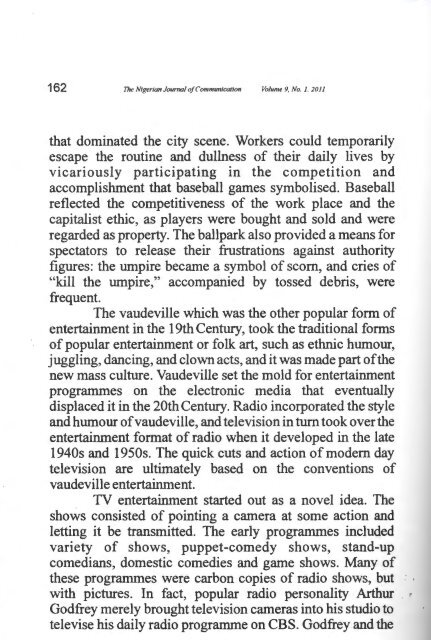Download (5Mb) - Covenant University Repository
Download (5Mb) - Covenant University Repository
Download (5Mb) - Covenant University Repository
Create successful ePaper yourself
Turn your PDF publications into a flip-book with our unique Google optimized e-Paper software.
162 The Nigerian Journal of Communication Volume 9, No. I. 201 I<br />
that dominated the city scene. Workers could temporarily<br />
escape the routine and dullness of their daily lives by<br />
vicariously participating in the competition and<br />
accomplishment that baseball games symbolised. Baseball<br />
reflected the competitiveness of the work place and the<br />
capitalist ethic, as players were bought and sold and were<br />
regarded as property. The ballpark also provided a means for<br />
spectators to release their frustrations against authority<br />
figures: the umpire became a symbol of scorn, and cries of<br />
"kill the umpire," accompanied by tossed debris, were<br />
frequent.<br />
The vaudeville which was the other popular form of<br />
entertainment in the 19th Century, took the traditional forms<br />
of popular entertainment or folk art, such as ethnic humour,<br />
juggling, dancing, and clown acts, and it was made part of the<br />
new mass culture. Vaudeville set the mold for entertainment<br />
programmes on the electronic media that eventually<br />
displaced it in the 20th Century. Radio incorporated the style<br />
and humour of vaudeville, and television in tum took over the<br />
entertainment format of radio when it developed in the late<br />
1940s and 1950s. The quick cuts and action of modem day<br />
television are ultimately based on the conventions of<br />
vaudeville entertainment.<br />
TV entertainment started out as a novel idea. The<br />
shows consisted of pointing a camera at some action and<br />
letting it be transmitted. The early programmes included<br />
variety of shows, puppet-comedy shows, stand-up<br />
comedians, domestic comedies and game shows. Many of<br />
these programmes were carbon copies of radio shows, but<br />
with pictures. In fact, popular radio personality Arthur<br />
Godfrey merely brought television cameras into his studio to<br />
televise his daily radio programme on CBS. Godfrey and the
















